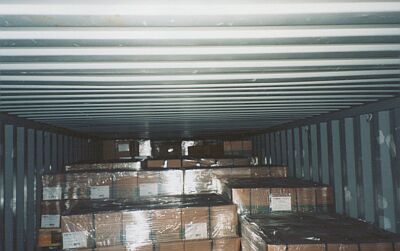An ordinary, everyday situation:
 |
|
| Unfavorable pallet dimensions in a 20' ISO export container |
The pallets used measure 800 mm x 1,200 mm and are thus not suitable for container use. The pallets are also not neatly packed and include gaps (1). Due to their design, they only have a strip-like bearing surface (2) which consequently generates high pressures. The edge of pallet (3) is sticking out beyond the cargo. Moreover, the strapping is so badly placed that it could break during forklift truck handling. The gaps between the pallets and at (4) between container side wall and pallet (3) and are too large.
Considerable effort would be required in order to achieve a compact stow without gaps.
 |
|
| Excessively large number of pallets to fill gaps |
Pallet (2) ought to be lifted up to allow placement of interlayer dunnage to distribute the pressure. Ten pallets would be required to fill the gaps (5) with pallets. Such a large number just for these gaps is unacceptable.
It is specifically stated in point 3.2.12 of the CTU packing guidelines that, when deciding on packaging and cargo securing material, it should be borne in mind that some countries enforce a garbage- and litter-avoidance policy. It is furthermore stated that this may lead to limitations on the use of certain materials and imply fees for the recovery of packaging.
A compact stow achievable due to the dimensions of the cargo is the most economic method of cargo securing.
 |
|
| Compactly stowed container - partly staggered |
Although packing was carefully carried out and gaps were avoided or filled, the traffic light is still at red.
 |
|
| Inadequate securing of a relatively large gap in door area |
The squared lumber member placed between the container corrugations to block the gap remaining in the door area is not adequate. The lumber crosspiece used could not withstand inertia forces generated by the cargo, especially if this container were stowed athwartships on board ship or if precarriage or onward carriage were by rail.
 |
|
| Risk of damage to container corrugations by squared lumber |
The squared lumber could be forced out, probably also resulting in damage to the container walls.